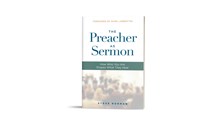
In a recent N.Y. Times Magazine interview, three TV executives commiserate over the pressure to come up with a new, blockbuster sitcom or dramatic series. A successful series not only captures a large audience for that time slot, but serves as an anchor show that secures viewers for the entire evening, and positions the network in the marketplace. In the words of one of these media moguls, "Everyone's looking for the next Friends."
Preaching pastors feel their pain. We're always in search of the next sermon series. For me, the most vexing question in preaching is not, How will I preach this text? but, What will I preach next? Like those executives, we know that an effective sermon series not only captures the attention of the listeners for thirty minutes a week, it breathes life into other ministries and shapes the culture of the church.
Series preaching is not a new idea. I grew up under a pastor who routinely preached his way through books of the Bible or relevant topics, and I have followed his lead from my first days of preaching. But over the past 20 years of preparing preaching calendars, I have discerned several changes in my approach to series preaching.
Shorter
The length of a typical sermon series has gotten progressively shorter. Forty years ago it was common for a pastor to spend many months or an entire year in a Book of the Bible. When I first began preaching, I would settle on three or four major series for the year, allowing wiggle room for holidays and a stewardship message, and that would pretty much do it. A series in those days was roughly the length of a school term: about 12 weeks. But somewhere along the way, America's collective attention span shortened, and 12 weeks felt like a long time to talk about anything.
The pace of life continues to quicken, the cultural attention-deficit increases, and things change more rapidly and unpredictably than ever. Shorter series allow us to be more nimble in responding to the changing mood of the nation or to the needs of the congregation. Shorter series also provide frequent entry points for a transient population, and multiple opportunities in a year to connect with a variety of felt needs. Seeking people are more likely to commit to a few weeks than to three months. Most of my series now run from three to seven weeks. If I want to cover a Book of the Bible, I'll deal with it thematically—pulling out the highlights—or else cover it in two or three installments spread out over a year or two.
Sharper Focus
It used to be that a simple, generic title was enough to capture interest and give a sense of movement through the year. Series titles like The Miracles of Jesus, or The Church in Action (), or Beginnings (Genesis 1) worked just fine. Sometimes I would dive in to the series not even certain where it would lead. In this age of specialization and consumerism, I find people want to know exactly what they're getting, and why it will be worth their time.
Packaging the series with clear, compelling titles and subtitles is more important than ever. A dozen years ago I did a rambling series from the Sermon on the Mount entitled simply, Kingdom Living. This time around I called it, The Life God Wants for You, and each week introduced them to a specific dimension of life in the Kingdom of God. Summer in the Psalms was enough to capture attention in the '80s. In 2001 a similar study became Real Life, Real Prayers.
More Strategic
It used to be a pastor's goal was simply to give a balanced offering of Old and New Testament Books, covering the major points of Christian life and doctrine in the course of a year. Now I find myself much more intentional in my series selection, looking to cast vision, reinforce ministry values, and shepherd the congregation strategically throughout the year.
Typically I lead off in the fall with a pacesetting series that casts a specific vision for the ministry year to come. A series from Romans 12 entitled, Discovering the Joy of Authentic Community sets the tone and direction for a year in which community-building is a primary objective. As the year unfolds, I'll do a series for each of our four core values—worship, community, discipleship, and outreach—but that first series in the fall gives us momentum in a particular direction that carries us throughout the year.
While we try to be seeker-friendly throughout the year in our worship and preaching, we are especially sensitive to times of the year when visitors are most likely to attend and our people are most likely to bring friends, like Advent and the Easter season. I usually do a seeker-oriented series for three weeks following Easter, speaking to a felt-need like, Faith for Monday Morning or When Life Gets Out of Control.
I have found the summer months to be rich with newcomers—people moving into the area or wanting to make a change in their lives—so I preach pre-evangelistically in the summer, often working out of the Gospels or the Psalms. During the Lenten season, I preach devotional texts and themes appropriate to the season, being especially sensitive to nurturing the believers' intimacy with God.
Multidimensional
In recent years we have discovered that sometimes a sermon series can be much more than a sermon series. That is, the messages are just one of many components in a broader campaign to effect change in the lives of people or the church. Chapel of the Air pioneered this approach several years ago with the 50 Day Spiritual Adventure, in which a thematic preaching series of 8 messages was complemented by daily study guides, small group materials, and learning activities designed to personalize and reinforce the messages from the pulpit. This fall Saddleback Church took a similar approach in its 40 Days of Purpose series, made available to churches nationwide. The idea is to engage the congregation on a variety of levels, appealing to multiple learning-styles over a long enough period of time to allow real transformation to begin.
We took a multidimensional approach to our pacesetting series this fall. Our vision is for Grace Chapel to become "A Church You Bring Your Friends To." This fall we wanted to challenge our people to be building genuine friendships with unbelievers and to be praying for opportunities to invite them to an event at church. In order to accomplish that we planned a church-wide campaign we called People Bringing People. In partnership with our evangelism pastor, I laid out a 5-week preaching series from the Gospels looking at stories of what happened when people brought other people to Jesus: Andrew and his brother, the four men who lowered their friend through the roof, Jairus and his daughter (presented as a dramatic monologue), a group of townsfolk who brought the deaf and mute man, and the Samaritan woman bringing her neighbors. Each message was supported by a drama, an interview, or a faith story.
In addition to the Sunday services, we offered a personal study guide with daily readings and action steps. We also custom-designed small group studies that explored the preaching texts and applications in greater depth. A logo for the series reinforced the message visually on the weekly worship folder and on posters and banners around the facilities. On one of the Sundays, we invited people to go to banners on the side walls in the sanctuary and write the names of people they were praying for, asking God for the opportunity to strengthen those friendships and to invite them to some upcoming outreach events. We made bookmarks available as prayer reminders.
The series culminated in an Open House Sunday in which we encouraged people to bring friends to services designed especially to introduce them to the church. I spoke that day on True Friends, exploring the spiritual dimension of friendships from the story of Philip and Nathaniel. What could have been a simple sermon series became a culture-creating event by engaging the entire congregation in a variety of learning activities.
As the TV executives wind down their conversation, one of them suggests that "the hardest thing to do in show business, by far, is to create and execute a high-quality, successful, long-running television series." They all agree that the relentless pursuit of the next big thing is essential to their effectiveness as leaders and to the success of their networks. In some measure, I feel the same way about sermon series.











